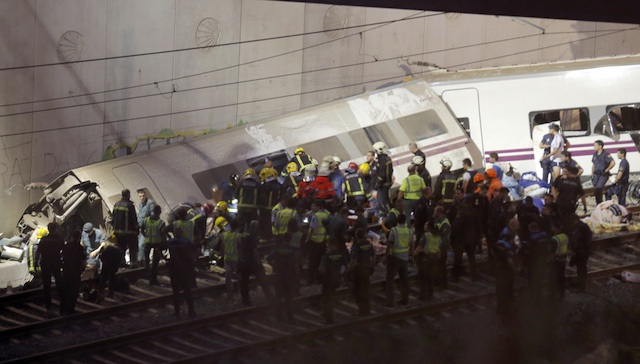SUMMARY
This is AI generated summarization, which may have errors. For context, always refer to the full article.

SANTIAGO DE COMPOSTELA, Spain (5th UPDATE) – A train hurtled off the tracks in northwest Spain killing at least 80 passengers and injuring more than 140, an official said Thursday, July 25, the country’s deadliest rail disaster in 44 years.
Four carriages overturned in the smash late Wednesday, July 24, smoke billowing from the wreckage, as bodies were lain out under blankets along the tracks.
The carriages piled into each other and folded up like an accordion. One was ripped apart by the force of the crash, one of its ends pushed up into the air.
Several witnesses spoke of a loud explosion.
“I was at home and I heard something like a clap of thunder, It was very loud and there was lots of smoke,” said 62-year-old Maria Teresa Ramos, who lived just meters from where the accident happened.
“It’s a disaster, people are crying out. Nobody has ever seen anything like this,” she added.
Her neighbor Martin Rozas, 39, helped pull the wounded from the wreckage and laid blankets over the dead. “It was like an earthquake,” he said.
The accident happened at 8:42 pm (1842 GMT) Wednesday as the train carrying 218 passengers and four staff was about to enter Santiago de Compostela station in the northwestern region of Galicia.
It marks the worst rail accident in Spain since 77 people were killed in 1972 in a derailment in Andalusia in the south.
In 1944, hundreds were killed in a crash also between Madrid and Galicia.
Rescue workers recovered 73 bodies from the train’s wreckage and four more victims died later in hospital, a spokesman for the Galicia high court said Thursday, increasing an earlier toll figure.
A total of 143 people were said to have various injuries.
Francisco Otero, 39, who was inside his parents’ home just beside the section of the track where the accident happened, said he “heard a huge bang”.
“The first thing I saw was the body of a woman. I had never seen a corpse before. But above all what caught my attention was that there was a lot of silence, some smoke and a small fire,” he told AFP.
“My neighbors tried to pull out people who were trapped inside the carriages with the help of pickaxes and sledgehammers and they eventually got them out with a hand saw. It was unreal.”
Speeding train
The train had left Madrid and was heading for the town of Ferrol as the Galicia region was preparing celebrations in honor of its patron saint James.
A witness told radio Cadena Ser that carriages overturned several times on a bend and came to a halt piled up on each other.
Public television TVE said the train may have derailed because it was speeding at the time of the accident but a spokesman for state railway company Renfe said it was too soon to say what caused the accident.
“There is an investigation underway and we have to wait. We will know what the speed is very soon when we consult the train’s black box,” a Renfe spokesman said.
“Deadly High Speed” the El Mundo daily’s headline ran. The paper reported that the train had been traveling at 220 km (136 miles) per hour in an urban zone with a speed limit of 80 kph.
The El Pais suggested the train was traveling at 180 km/h when the accident happened.
The accident happened on a stretch of high-speed track about 4 km (2.5 miles) from the main train station in Santiago de Compostela, the destination of the famous El Camino de Santiago pilgrimage which has been followed by Christians since the Middle Ages.
The train was the Alvia model which is able to adapt between high-speed and normal tracks.
Emergency services workers in red jackets tended to injured passengers lying on a patch of grass as ambulance sirens wailed in the background.
“There are bodies laying on the railway track. It’s a Dante-esque scene,” Alberto Nunez Feijoo, president of the regional government, told news radio Cadena Ser.
A municipal building was made available for psychological counseling and as a centre for providing information.
Carriages were lying across the tracks, some of them jammed alongside a concrete siding.
Prime Minister Mariano Rajoy, who is from Santiago de Compostela, was to visit the scene of the accident later on Thursday.
“I want to express my affection and solidarity with the victims of the terrible train accident in Santiago,” he said in a Twitter message.
Pope Francis called for prayers for the victims.
The town hall of Santiago de Compostela called off concerts and firework displays that had been planned as part of the festivities in honor of its patron saint. – Rappler.com
Add a comment
How does this make you feel?
There are no comments yet. Add your comment to start the conversation.